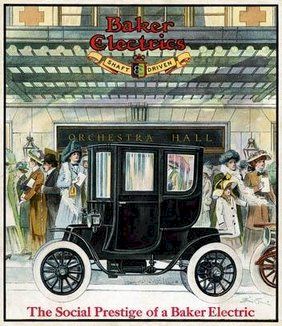Baker Motor Vehicle Company was a manufacturer of
Brass Era
electric
automobiles in
Cleveland, Ohio from 1899 to 1914.
The first Baker vehicle was a two seater with a selling
price of
US$ 850. One was sold to
Thomas Edison as his first car.
Edison also designed the
nickel-iron batteries used in some Baker electrics. These batteries
have extremely long lives, and some are still in use.
The model range was expanded in 1904 to two vehicles,
both two-seaters with armored wood-frames, centrally-located electric
motors, and 12-cell batteries. The
Runabout had 0.75 hp (0.6 kW) and weighed 650 lb (295 kg). The
Stanhope cost US$1600, weighed 950 lb (431 kg), had 1.75 hp
(1.3 kW) and three-speed transmission. It was capable of 14 mph
(23 km/h).

In 1906 Baker made 800 cars, making them the largest
electric vehicle maker in the world at the time.
By 1907, Baker had seventeen models, the smallest being
the Stanhope and the largest the Inside Drive Coupe. There was
also the US$4000 Extension Front Brougham with the driving seat
high up behind the passengers mimicking a
Hansom cab. Baker also introduced a range of trucks with capacity of
up to 5 tons.

1909 Baker Motor Vehicle Ad.
In 1913 Baker was overtaken in sales by
Detroit Electric and in 1914 merged with fellow Cleveland automaker
Rauch and Lang to become Baker, Rauch & Lang.
The last Baker cars were made in 1916, but electric industrial trucks
continued for a few more years. Baker, Rauch & Lang went on to make the
Owen Magnetic under contract.
Founder Walter C. Baker's Torpedo
land speed record racer was the first car to have
seat belts. The car was capable of over 75 miles per hour
(121 km/h).
Walter Baker joined the board of
Peerless in 1919.
